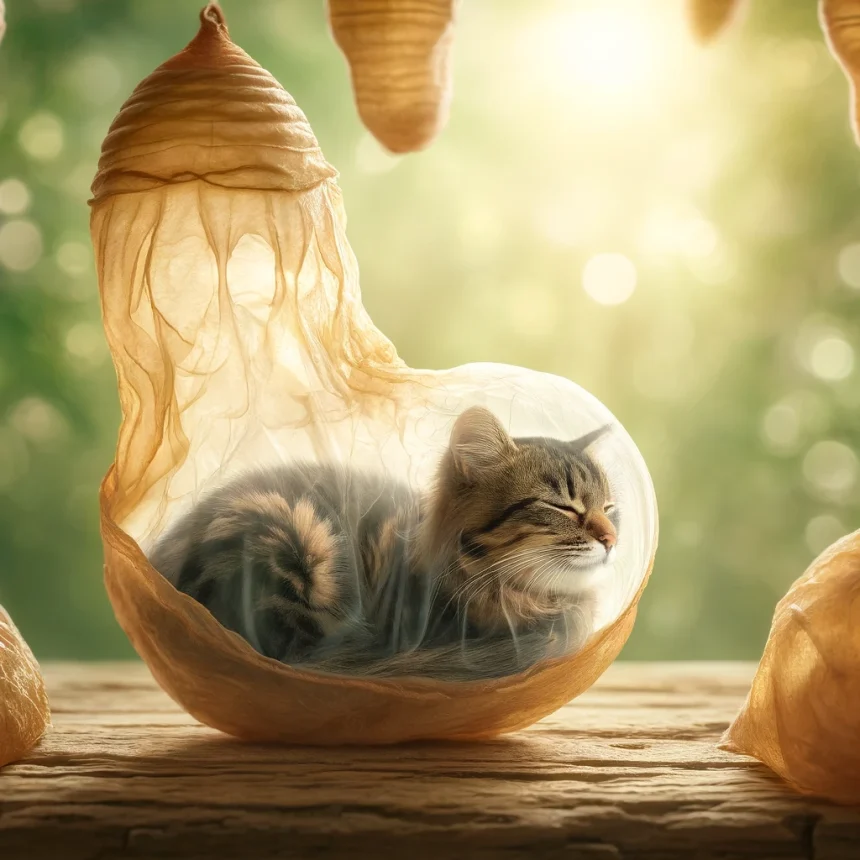“Cat in the Chrysalis”, the latest thrilling novel by acclaimed author, has captivated readers with its intricate plot and compelling characters. This review delves into the book’s pivotal themes and major plot twists, offering a comprehensive analysis for those who’ve journeyed through its pages or are curious about the hype. Be warned, spoilers lie ahead!
Intriguing Premise
“Cat in the Chrysalis” is set in a quaint yet eerie village, where the disappearance of a beloved cat named Whiskers sets off a series of unexpected events. The narrative cleverly interweaves elements of mystery, fantasy, and psychological drama, as the protagonist, Eliza, begins to uncover that Whiskers’ disappearance is merely the surface of a much deeper, darker secret.
The Core Mystery: What is the Chrysalis?
Central to the storyline is the enigmatic concept of the “Chrysalis.” Initially believed to be a physical cocoon, it is gradually revealed to be a metaphorical state affecting the village’s inhabitants. The Chrysalis represents transformation and the often painful shedding of old for new. This revelation is pivotal as it shifts the reader’s understanding of the plot’s progression and the characters’ motivations.
Character Development: Eliza’s Journey
Eliza, the heart of the novel, is portrayed with remarkable depth. Her journey from a curious neighbor to a determined truth-seeker is compelling. As she investigates, she confronts not only external dangers but also internal crises, reflecting on her own fears and desires. Her growth is intricately depicted, mirroring the thematic elements of transformation and revelation that the Chrysalis symbolizes.
Plot Twists and Climax
The climax of the book is a brilliantly executed twist where Eliza discovers that the Chrysalis’s effect can be reversed, but at a great personal cost. The moral dilemmas presented—whether to change the past if given a chance, and at what cost—add a philosophical layer to the narrative, pushing the reader to question their own beliefs about fate and personal growth.
Implications and Themes
“Cat in the Chrysalis” explores themes of identity, change, and the nature of reality. The book questions the line between reality and perception, urging readers to think about how their past shapes their present. Additionally, it challenges the notion of community and individual responsibility, making it a rich source for discussion.
Rating: ★★★★☆
For its brilliant narrative structure and deep philosophical underpinnings, “Cat in the Chrysalis” earns a well-deserved four out of five stars. While the pacing may slow in the middle, the payoff is immensely satisfying, making it a worthy addition to any reader’s bookshelf
This analysis of “Cat in the Chrysalis” aims to provide a detailed look at its themes and narrative achievements, helping potential readers understand the depths of its story and encouraging a broad discussion about its implications. Whether you’re a fan of psychological dramas, mysteries, or stories of personal transformation, this novel promises a journey worth taking
Reader Engagement and Reflection
“Cat in the Chrysalis” does an exceptional job of not only engaging its readers through suspense and mystery but also encourages them to reflect on their own lives and transformations. The novel serves as a mirror, reflecting back the often uncomfortable truths about growth and change. As Eliza uncovers layers of the mystery, readers too are prompted to peel back layers of their own perceptions and beliefs.
Symbolism: Beyond the Literal
Beyond the literal journey of Eliza and the missing cat Whiskers, the novel is rife with symbolism. The Chrysalis itself, initially a source of confusion, comes to symbolize the potential for rebirth amidst the struggles of life’s challenges. Each character in the village, affected by the Chrysalis in some way, represents various stages of transformation, making the novel a rich tapestry of human experience and emotion.
Impact on the Genre
With its unique blend of genres, “Cat in the Chrysalis” stands out in the realm of contemporary literature. It borrows elements from traditional mysteries and psychological thrillers but introduces a fresh philosophical twist that challenges the conventions of both genres. This novel not only provides entertainment but also contributes significantly to literary discussions about genre blending and narrative innovation.
For Whom is This Book a Must-Read?
This novel is particularly suited for readers who appreciate depth along with their intrigue. It is perfect for those who enjoy books that not only entertain but also provoke thought, offering insights that linger long after the last page is turned. Book clubs would find “Cat in the Chrysalis” an excellent choice for discussions, given its complex characters and rich thematic content.
Enhancing Your Reading Experience
For those planning to read “Cat in the Chrysalis,” consider keeping a journal to jot down thoughts and observations as you go through the chapters. This can enhance your engagement with the book and provide a deeper appreciation of its themes. Discussing the book with friends or in a book club setting can also enrich your understanding and offer diverse perspectives on its many layers.
Conclusion
“Cat in the Chrysalis” is a compelling blend of mystery, drama, and philosophical musing. It’s masterful storytelling invites readers into a deeply immersive world that is both familiar and startlingly new. The novel is a testament to the power of narrative to explore and reflect upon the profound aspects of human life and evolution. It deserves a prominent place on the shelves of those who cherish books that not only tell a story but also question and explore the very nature of storytelling itself.






